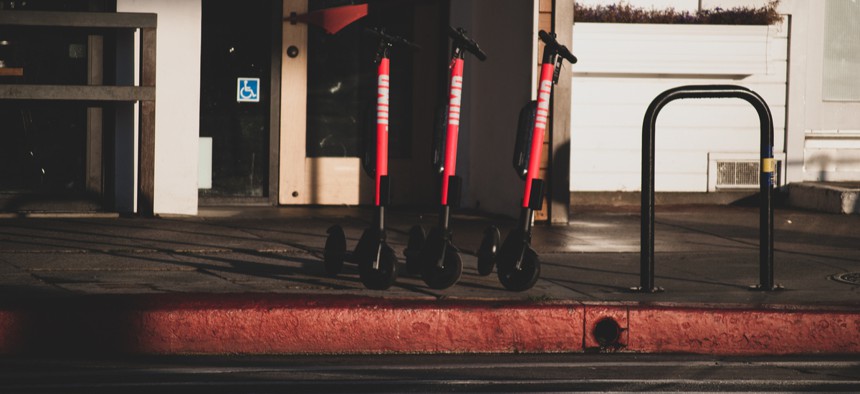Mapping the Digital Curb

The data could be used to create designated parking for scooters, among other things. Shutterstock
A data mobility company released an open-data initiative that maps the physical features of curbs in six cities, with the goal of reducing congestion and improving accessibility.
Some of the most in-demand real estate in cities sits on the side of busy streets.
It’s the curb—where passengers hop in and out of Ubers, where Postmates drivers idle to deliver takeout to hungry customers and where dockless scooters and bikes get picked up and dropped off by commuters. But despite the rising street-side traffic, most cities don’t have comprehensive maps showing the parking signs, fire hydrants or bus stops along their curbs.
Enter Open Curbs, a new initiative from Coord that aims to create the “digital curb.” The project places a city’s curbside data on a digital map, allowing officials, planners and business groups to visualize those assets—in some cases, for the first time.
“The first thing we observed when we started was that most cities don’t have, or distribute publicly, a digital representation of their curbs and the things on those curbs,” said Stephen Smyth, CEO and co-founder of Coord, a spinoff of Sidewalk Labs, which is a subsidiary of Alphabet. “You might think that’s obvious, but it’s not. Some cities have pretty good information on that, but most do not.”

For now, the data covers six cities in both the United States and Europe—Denver, Los Angeles, San Francisco, Santa Monica, Calif., Paris and Milan—with more to come. Most of the information contained in the data sets came from the company’s Surveyor app, which uses augmented reality to help users catalog street signs and parking meters block by block. That technology is geared mostly toward professional users, including surveyors, while Open Curbs is accessible to everyone.
“Open Curbs is really the first batch of other users of the Surveyor tool choosing to release some of the collections they have made of this asset data, and joining forces,” Smyth said. “Our hope is to introduce the concept of the digital curb not just across America, but the world, and to provide a one-stop shop for not just folks in the industry—engineers, city agencies, mapping analysts—but also for community activists, nonprofits and researchers.”
The overarching goal is to improve accessibility across cities, starting at the curb. That can mean eliminating congestion from discarded scooters and bikes, or simply making curb rules easier for members of the public to access and understand.
“A lot of folks are not sure what the curb rules are,” Smyth said. “We regularly get requests for parking maps and things like that. Cities could post that on their websites or in their mobile app for residents, visitors and businesses.”
The data sets also have “analytical uses—being able to not just to view the regulations, but filter in different things, by type, duration and price,” he said. “Ultimately, the city managers are trying to understand supply and demand.”
The demand for curb real estate is particularly high in downtown Santa Monica, where scooters and ride-sharing companies fight for space with delivery vehicles and cars. Decisions about what goes where on each curb are made piecemeal, rather than holistically, resulting in a patchwork of uses that can be confusing for visitors and residents.
“We wanted to have a real idea of what was out there, and we didn’t have a map that told us what you can do in what space in our town,” said Hector Soliman-Valdez, mobility manager for Downtown Santa Monica, Inc., a nonprofit group that works with the city to manages the downtown area. “Our first step was trying to wrap our heads around all those different issues.”
The organization partnered with Coord to use the Surveyor app to map the downtown, then shared the data with the company as part of the Open Curbs project. The result is a digital map of the downtown district that allows users to drill down to individual parking signs, fire hydrants and curb stencils. That’s useful for visitors, but also for city officials and business owners trying to navigate an increasingly congested—and important—space.
“It’s good to have,” Soliman-Valdez said, “and because we have it, we can look at it and say, ‘We can solve this problem by checking through the map.’”
Kate Elizabeth Queram is a Staff Correspondent for Route Fifty and is based in Washington, D.C.
NEXT STORY: AI may read soldiers' intents, anticipate their needs





